#FDR
Explore tagged Tumblr posts
Text
red and blue roses 🌹



i like their last name. it's really fancy :))
explanation of this series here in the caption of this post

"how's your side of the rose field?"
#shitpost#cursed anime girlification(?)#us history#us presidents#theodore roosevelt#teddy roosevelt#fdr#franklin d. roosevelt#franklin delano roosevelt
207 notes
·
View notes
Text

scrunkly blorbos except they’re a nuanced dead person that you need to handle with care like a fragile package
#bruce ismay#teddy roosevelt#fdr#franklin d roosevelt#us presidents#titanic#historical figures#history#robespierre#french revolution#sorry just tagging all my beloveds….#antonio salieri
2K notes
·
View notes
Text
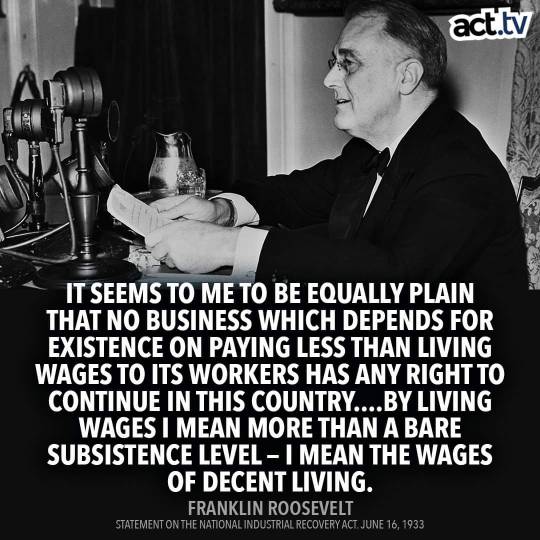
90 years later we are having the same conversation about capitalism and starvation wages.
616 notes
·
View notes
Text
"We must especially beware of that small group of selfish men who would clip the wings of the American eagle in order to feather their own nests." -FDR, 1941
2K notes
·
View notes
Text
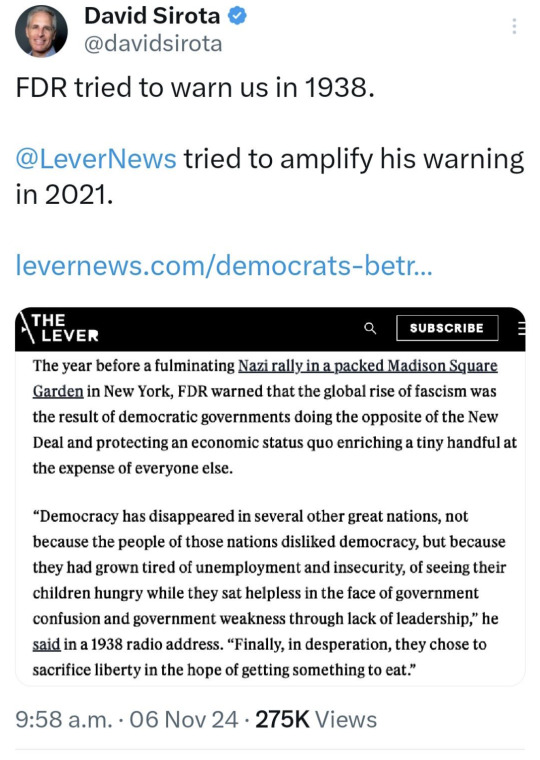
828 notes
·
View notes
Text
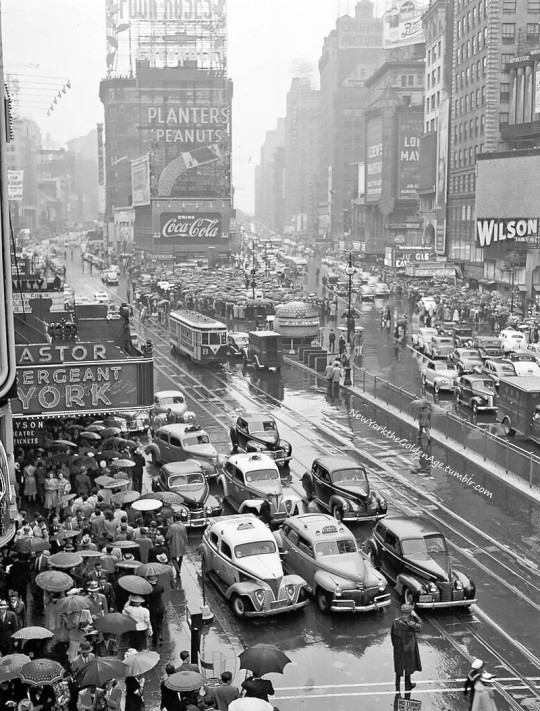
Automobile and foot traffic come to a complete halt in rainy Times Square as President Roosevelt delivers a speech, July 4, 1941. The president spoke via radio from the library at his home in Hyde Park, N.Y.
Photo: Tom Sande for the AP
#vintage New York#1940s#Tom Sande#July 4#4 July#Franklin D. Roosevelt#FDR#Times Square#Times Square rain#umbrellas#broadcast speech#1940s New York
259 notes
·
View notes
Text
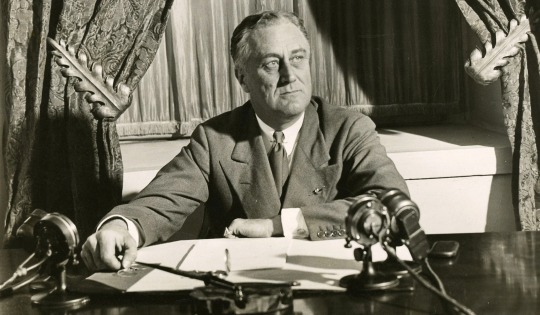
Human kindness has never weakened the stamina or softened the fiber of a free people. A nation does not have to be cruel in order to be tough. The vigorous expression of our American community spirit is truly important. The ancient injunction to love thy neighbor as thyself is still the force that animates our faith—a faith that we are determined shall live and conquer in a world poisoned by hatred and ravaged by war.
—Franklin D Roosevelt, radio address for the Mobilization for Human Needs, Oct 13, 1940
647 notes
·
View notes
Text

In another world, I heard
by AllanOdyne
#photography#photographers#original#canon#artists on tumblr#allanodyne#beautiful#travel#usa#new york#new york city#nyc#bw#sw#black and white photography#schwarzweiß#fence#snow#winter#cold#night#bridge#fdr#lantern#alternative girl#beauty on its own level#scenery#walk#cityscape
121 notes
·
View notes
Text
Greenbelt Maryland. Or, how America almost solved housing only to abandon it.

**I AM NOT AN EXPERT! I AM JUST AN ENTHUSIST! DO NOT TREAT MY OPINIONS/SPECULATION AS EDUCATION!**
During the Depression America faced a housing crisis that rhymes with but differs from our own. It’s different in that there wasn’t a supply issue, there were loads of houses in very desirable areas, but they were still unaffordable as people’s incomes collapsed causing a deflationary spiral. While the housing supply subtly grew and succeeded demand, people simply couldn’t pay the meager rents and mortgages. Herbert Hoover failed to manage the Depression, while his inaction is greatly exaggerated, his policy of boosting the economy with works projects and protecting banks from runs failed and the depression only got more pronounced in his term. In comes Franklin Roosevelt, a progressive liberal much like his distant and popular cousin/uncle-in-law Teddy. Franklin’s plan was to create a large safety net for people to be able to be economically viable even if they’re otherwise poor. These reforms are called the New Deal and they did many controversial things like giving disabled and retired people welfare, giving farmers conditioned subsidies to manipulate the price of food, a works program to build/rebuild vital infrastructure, etc. One of these programs was the USHA (a predecessor of America’s HUD), an agency created to build and maintain public housing projects with the goal of creating neighborhoods with artificially affordable rents so people who work low-wage jobs or rely on welfare can be housed.
In this spirit, the agency started experimenting with new and hopefully efficient housing blueprints and layouts. If you ever see very large apartment towers or antiquated brick low-rise townhouses in America, they might be these. The USHA bought land in many large and medium-sized cities to build “house-in-park” style apartments, which is what they sound like. Putting apartment buildings inside green spaces so residents can be surrounded by greenery and ideally peacefully coexist. Three entire towns were built with these ideas outside three medium-sized cities that were hit hard by the depression; Greenbelt outside DC, Greenhills outside Cincinnati, and Greendale outside Milwaukee. The idea was to move people out of these crowded cities into these more sustainable and idyllic towns. There were many catches though, the USHA planned for these towns to be all-white, they used to inspect the houses for cleanliness, they required residents to be employed or on Social Security (which basically meant retired or disabled), they also had an income limit and if your income exceeded that limit you were given a two-month eviction notice, and you were expected to attend town meetings at least monthly. While the towns didn’t have religious requirements they did only build protestant churches. Which is an example of discrimination by omission. While a Catholic, Jew, Muslim, etc could in theory move into town they also couldn’t go to a Catholic church, synagogue, or Islamic center without having to extensively travel. Things planned communities leave out might indicate what kind of people planned communities want to leave out. Basically, the whole thing was an experiment in moving Americans into small direct-democracy suburbs as opposed to the then-current system of crowded cities and isolated farm/mine towns. This type of design wasn’t without precedent, there were famously company towns like Gary and Pullman which both existed outside Chicago. But those lacked the autonomy and democracy some USHA apparatchiks desired.
The green cities were a series of low-rise apartments housing over a hundred people each, they were short walks from a parking lot and roads, and walking paths directly and conveniently led residents to the town center which had amenities and a shopping district. Greenbelt in particular is famous for its art deco shopping complex, basically an early mall where business owners would open stores for the townspeople. These businesses were stuck being small, given the income requirements, but it was encouraged for locals to open a business to prove their entrepreneurial spirit. Because city affairs were elected at town meetings the city was able to pull resources to eventually build their own amenities the USHA didn’t originally plan for like a public swimming pool or better negotiated garbage collection.
These three cities were regarded as a success by the USHA until World War II happened and suddenly they showed flaws given the shift in focus. These towns housed poor people who barely if at all could afford a car, so semi-isolated towns outside the city became redundant and pointless. The USHA also had to keep raising the income requirement since the war saw a spike in well-paying jobs which made the town unsustainable otherwise. During the war and subsequent welfare programs to help veterans, these green cities became de facto retirement and single-mother communities for a few years as most able-bodied men were drafted or volunteered. Eventually, the USDA would make the towns independent, after the war they raised the income limit yet again and slowly the towns repopulated. As cars became more common and suburbanization became a wider trend these towns would be less noticeably burdensome and were eventually interpreted as just three out of hundreds of small suburban towns that grew out of major cities. They were still all-white and the town maintained cleanliness requirements; after all they lived in apartments it just takes one guy’s stink-ass clogged toilet to ruin everyone’s day.
By the 1950’s these towns were fully independent. Greendale and Greenhills voted to privatize their homes and get rid of the income limit all together so the towns can become more normal. Greenhills, Ohio still has many of these USHA-era houses and apartments, all owned by a series of corporations and private owners. Greendale, Wisconsin property owners have demolished most of these old houses and restructured their town government so most traces of its founding are lost. But Greenbelt, Maryland still maintains a lot of its structure to this day. Greenbelt has privatized some land and buildings, but most of the original USHA apartments are owned by the Greenbelt Homes, Inc cooperative which gives residents co-ownership of the building they live in and their payments mostly go to maintenance. Because Greenbelt was collectively owned the House Un-American Activities Committee would blacklist and put on trial most of Greenbelt’s residents and officials. Though they didn’t find much evidence of communist influence, the town was a target of the red scare by the DMV area, residents were discriminated, blacklisted, and pressured into selling their assets. While Greenbelt did commodify some of the town, the still existing co-ownership shows the town’s democratic initiative to maintain its heritage. The green cities desegregated in the 50’s and 60’s depending on state law, Greenbelt was the last to desegregate under the Civil Rights Act of 1964, while discrimination persisted for years by the 1980’s the town would become half non-white, today the town is 47% black and 10% Asian.
Though these towns largely integrated with a privatized and suburbanized America, they do stand as a memorial to an idea of American urbanism that died. They were designed for walkability and were planned to be more democratic and egalitarian towns, with the conditions that came with segregation and government oversight. You can’t ignore the strict standards and racism in their history, but you can say that about many towns. How do you think America would be different if more cities had green suburbs that were more interconnected and designed for community gatherings?
#urbanism#DC#maryland#dmv#Cinncinatti#milwaukee#ohio#wisconsin#New Deal#history#fdr#franklin roosevelt#politics#urban#city#apartment#housing#great depression#article#co op#socialism#segregation#discrimination#housing crisis#landlords#united states
233 notes
·
View notes
Text
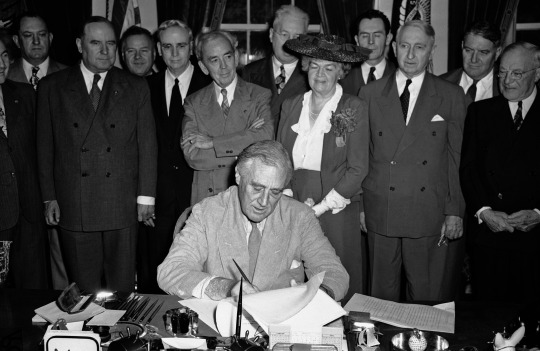
President Franklin D. Roosevelt signing the G.I. Bill on June 22, 1944, an unprecedented act of legislation designed to compensate returning members of the armed services—known as G.I.s—for their efforts in #WWII
91 notes
·
View notes
Text
Yes, Madam President!: The Series 🦅⭐









finally gave an actual title for this art series. 😍😊
For those wondering about my notes on Taylor and Fillmore here they are:


#cursed anime girlification(?)#us history#us presidents#amrev#antebellum#too many people to tag#george washington#abraham lincoln#thomas jefferson#teddy roosevelt#franklin d. roosevelt#fdr#andrew jackson#john f kennedy#richard nixon#lyndon b. johnson#and everyone else yay#yes madam president: the series
235 notes
·
View notes
Text

80 years since FDR left us 😭💔
80 notes
·
View notes
Text

140 notes
·
View notes
Text
I sometimes see people talk about the trump administration in terms of something along the lines of “we had to have Hoover before FDR” as if the situations were comparable. Hoover didn’t have a cult of personality that conservatives would throw themselves off a bridge for. Hoover didn’t kill hundreds of thousands of Americans and still win election. People keep looking back to history and comparing it to the present in a 1 to 1 scenario
That is a mistake. History isn’t a mirror and doesn’t repeat. It can rhyme and it’s important to know history to understand the present. Hoover doesn’t equal trump and what comes after trump may not be the second coming of FDR. It’s good to have hope, but don’t bank on that hope. If you want to see a modern day FDR first let’s win the midterms. If we can’t even do that well.
#cbr politics#american politics#politics#trump administration#us politics#us history#history#FDR#herbert hoover#great depression#Donald trump#trump#AOC#Bernie Sanders
134 notes
·
View notes
Text
Comrades, further to my previous announcement, I present irrefutable visual evidence. Behold! The miracle of socialist reproduction, a testament to the…robustness…of the Soviet spirit. And yes, that IS Comrade Roosevelt by my side, radiating the warmth of Allied solidarity. Dare I say, he looks rather pleased with himself? #StalinIsPreggers #MiracleOfMarxism #RooseveltTheProudPapa
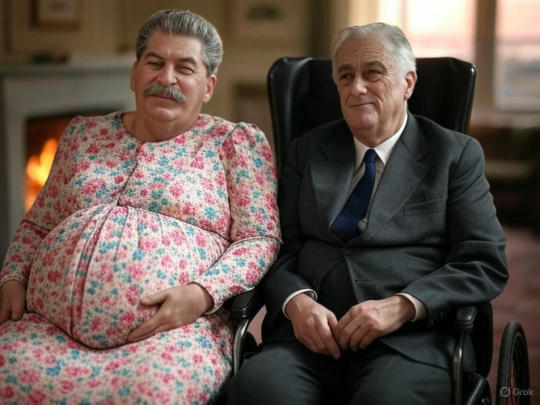
The bourgeoisie whisper, "How is this possible?" To them, I say: the laws of nature are merely bourgeois constructs! The will of the proletariat transcends such petty limitations. And besides, who are you to question the glorious union of Soviet steel and American… diplomacy? #ScienceIsBourgeois #AnythingIsPossibleWithCommunism #DontAskQuestionsJustBelieve
72 notes
·
View notes
